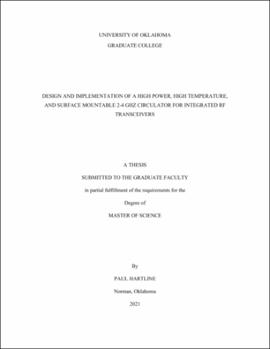| dc.description.abstract | With the advent of today’s wireless communications systems, the ability for non-local systems to listen to each other is critical. In the case of two monostatic systems communicating with each other, a signal of a given frequency is radiated, and the response listened for. Historically, the given signal had to be given in bursts, with the system set in transmission mode and switched over to a receiving mode in which to listen for a response. This switching mandated that the transmission and receiving modes be not connected, or else the transmitted signal could reach the receiving branch of the system, contaminating data. As the antenna had to switch between these branches, blind spots occurred for distances too close and too far away from the antenna to hear. If one required a maximal listening range in a monostatic system, data pulses had to be short, with a great deal of time in between sending. The solution for the problem turned out to be the circulator, a nonreciprocal device capable of allowing the transmission chain, the antenna, and the receiving chain to simultaneously be connected without signal interference. This nonreciprocity allowed RF power of a given frequency range to only travel in one direction of propagation and was achieved through the use of anisotropic ferrimagnetic materials. The only unfortunate reality of the circulator is the immense difficulty of the design and their unwieldy nature of integration. Compared to other devices operating at similar frequencies, circulators tend to be massive and weighty, with minimal options for integration. In this thesis, a design for a surface mountable octave bandwidth circulator operating at high temperatures and high power levels with a footprint of 1 square inch is presented. Potential fabrication difficulties are simulated and analyzed, with a time domain impedance analysis method used. Simulations and of this circulator display a 20 dB return loss and isolation bandwidth in excess of an octave in the S-band (2-4 GHz). Simulations and measurements show insertion loss is shown to be lower than 0.8 dB in the passband. This circulator demonstrates the feasibility of a high-performance 3D Tetris-like building block method that can be extended to ferrimagnetic circulators of any fractional bandwidth and operating frequency. | en_US |
